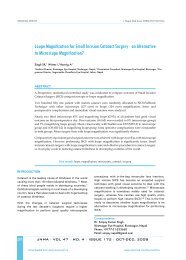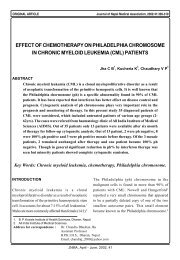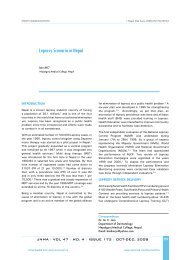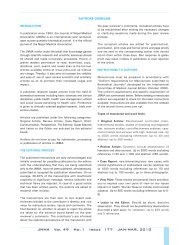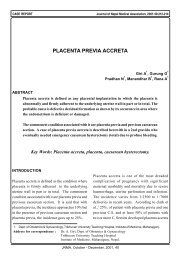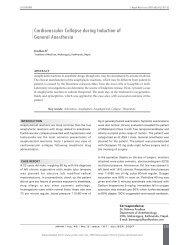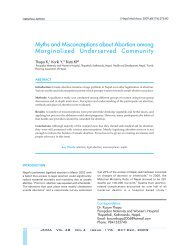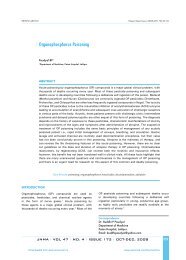epidermoid cyst of the spleen - Journal of Nepal Medical Association
epidermoid cyst of the spleen - Journal of Nepal Medical Association
epidermoid cyst of the spleen - Journal of Nepal Medical Association
Create successful ePaper yourself
Turn your PDF publications into a flip-book with our unique Google optimized e-Paper software.
CASE REPORT <strong>Journal</strong> <strong>of</strong> <strong>Nepal</strong> <strong>Medical</strong> <strong>Association</strong> 2003; 42: 297-299<br />
EPIDERMOID CYST OF THE SPLEEN: REPORT OF A CASE<br />
Bhadani P P * , Sah S P * , Afaque A *<br />
ABSTRACT<br />
Splenic <strong>epidermoid</strong> <strong>cyst</strong> is a rare entity and represents about 10% <strong>of</strong> <strong>the</strong> non-parasitic benign <strong>cyst</strong>s <strong>of</strong> <strong>the</strong><br />
<strong>spleen</strong>. We report a rare case <strong>of</strong> <strong>epidermoid</strong> <strong>cyst</strong> in a 45-year-old female who presented with pain and left<br />
upper abdominal mass. So far, such case has not been reported from <strong>Nepal</strong>.<br />
Key Words: Epidermoid <strong>cyst</strong>, <strong>spleen</strong>, late onset, meso<strong>the</strong>lial <strong>cyst</strong>.<br />
INTRODUCTION<br />
Epidermoid <strong>cyst</strong>s <strong>of</strong> <strong>the</strong> <strong>spleen</strong> are uncommon and represent<br />
about 10% <strong>of</strong> <strong>the</strong> non-parasitic benign <strong>cyst</strong>s <strong>of</strong> <strong>the</strong> <strong>spleen</strong>. 1<br />
The <strong>spleen</strong> can be involved in a variety <strong>of</strong> lesions ranging<br />
from <strong>cyst</strong>ic neoplasm and parasitic <strong>cyst</strong>s to “true” and “false”<br />
<strong>cyst</strong>s. 2 Epidermoid splenic <strong>cyst</strong> is a rare <strong>cyst</strong> <strong>of</strong> developmental<br />
origin. 1,2 Nonparasitic <strong>cyst</strong> <strong>of</strong> <strong>the</strong> <strong>spleen</strong> are classified as<br />
primary or epi<strong>the</strong>lial <strong>cyst</strong>s when <strong>the</strong>ir inner surface has a<br />
cellular lining. 3 The diagnosis depends on <strong>the</strong> surgical ablation<br />
<strong>of</strong> <strong>the</strong> <strong>cyst</strong> and histopathological examination. 4<br />
hyperechoic. Total splenectomy was performed under general<br />
anes<strong>the</strong>sia and <strong>the</strong> <strong>spleen</strong> was sent for histopathological<br />
examination.<br />
Grossly <strong>spleen</strong> measured 11 X 8 X 9 cm (Fig 1a). Cut section<br />
Fig. 1a<br />
CASE REPORT<br />
A 45-year-old lady presented with history <strong>of</strong> pain and left upper<br />
abdominal mass <strong>of</strong> two months duration. Pain was mild, nonradiating<br />
and was not related with food and vomiting. Her<br />
past history did not reveal any medical or surgical problem.<br />
There was no history <strong>of</strong> trauma or parasitic infestation.<br />
General physical examination showed mild pallor. Abdominal<br />
examination revealed splenic enlargement <strong>of</strong> about 4 cm below<br />
costal margin. It was firm in consistency and non-tender. Her<br />
haemogram and coagulation pr<strong>of</strong>ile were within normal limits.<br />
Ultrasonography suggested huge splenic <strong>cyst</strong> which was<br />
Fig. 1a : Outer aspect <strong>of</strong> splenectomy specimen.<br />
showed a unilocular <strong>cyst</strong> filled with serous fluid. The thickness<br />
<strong>of</strong> <strong>cyst</strong> wall varied from 0.2 to 1 cm. At one pole <strong>the</strong> <strong>cyst</strong> wall<br />
with increased thickness had appearance <strong>of</strong> normal splenic<br />
tissue. Inner lining <strong>of</strong> <strong>cyst</strong> was white and coarsely trabeculated<br />
(Fig 1b).<br />
Microscopic examination <strong>of</strong> <strong>the</strong> <strong>cyst</strong> wall showed single layer<br />
<strong>of</strong> low cuboidal cells resembling meso<strong>the</strong>lium, with underlying<br />
* B.P. Koirala Institute <strong>of</strong> Health Sciences, Dharan, <strong>Nepal</strong>.<br />
Address for correspondence : Dr. Punam Prasad Bhadani<br />
Department <strong>of</strong> Pathology<br />
B.P. Koirala Institute <strong>of</strong> Health Sciences, Dharan, <strong>Nepal</strong>.<br />
Email: ukbhadani275@yahoo.com<br />
JNMA, September - October, 2003, 42
Bhadani et al. Epidermoid <strong>cyst</strong> <strong>of</strong> <strong>spleen</strong> 298<br />
DISCUSSION<br />
Fig. 1b<br />
Fig. 1b : Specimen <strong>of</strong> splenic <strong>cyst</strong>, inner surface showing opaque<br />
white and trabeculated appearance.<br />
Fig. 2a<br />
Fig. 2a : Photomicrograph <strong>of</strong> <strong>the</strong> splenic <strong>cyst</strong> showing a single<br />
layer <strong>of</strong> cuboidal meso<strong>the</strong>lial cells residing on a fibrous<br />
stroma and splenic parenchyma (H & E; X 40).<br />
Splenic <strong>cyst</strong>s are parasitic or non-parasitic based on <strong>the</strong>ir<br />
aetiology and true <strong>cyst</strong> (primary) or pseudo<strong>cyst</strong> (false,<br />
secondary) based on <strong>the</strong> presence or absence <strong>of</strong> lining<br />
epi<strong>the</strong>lium. 2 Depending upon <strong>the</strong> pattern <strong>of</strong> <strong>the</strong> inner surface<br />
cell layer, <strong>the</strong> primary splenic <strong>cyst</strong>s are divided into meso<strong>the</strong>lial<br />
or <strong>epidermoid</strong> subtypes. 3 However both types <strong>of</strong> <strong>the</strong>se <strong>cyst</strong>s<br />
are included under <strong>the</strong> study <strong>of</strong> <strong>epidermoid</strong> <strong>cyst</strong>.<br />
The <strong>epidermoid</strong> splenic <strong>cyst</strong>s are rare and are usually seen in<br />
children and young adults and contribute about 10% <strong>of</strong> <strong>the</strong><br />
non-parasitic benign <strong>cyst</strong>s <strong>of</strong> <strong>the</strong> <strong>spleen</strong>. 1-9 Histogenesis <strong>of</strong> true<br />
<strong>cyst</strong> is unknown. It is believed that <strong>the</strong> epi<strong>the</strong>lial lined splenic<br />
<strong>cyst</strong>s are <strong>the</strong> result <strong>of</strong> invagination <strong>of</strong> surface capsular<br />
meso<strong>the</strong>lium with subsequent <strong>cyst</strong>ic expansion and metaplastic<br />
changes. 3,6 These <strong>cyst</strong>s are caused by an abnormal development<br />
during <strong>the</strong> seventh week <strong>of</strong> <strong>the</strong> intrauterine life. 1 Their<br />
occurrence in childhood fur<strong>the</strong>r supports <strong>the</strong> developmental<br />
nature <strong>of</strong> <strong>the</strong>se <strong>cyst</strong>s.<br />
Most splenic <strong>cyst</strong>s are <strong>of</strong>ten asymptomatic and symptoms relate<br />
to both <strong>the</strong> size <strong>of</strong> <strong>the</strong> mass, compression <strong>of</strong> an adjacent organ<br />
and complications. 7,13 Duvoisin B et al 10 emphasize <strong>the</strong> rarity<br />
<strong>of</strong> <strong>the</strong> lesion, which can be noted on plain films,<br />
ultrasonography and computed tomography. The case under<br />
discussion was asymptomatic upto 45 years <strong>of</strong> age, which is<br />
unique about this case and was brought to attention by pain<br />
and abdominal mass and was diagnosed as splenic <strong>cyst</strong><br />
ultrasonographically.<br />
Fig. 2b<br />
Tsakayannis DE et al .4 reviewed cases till 1993 and observed<br />
that <strong>the</strong> age at <strong>the</strong> time <strong>of</strong> presentation ranged from newborn<br />
to 17 years (median 12 years). The male: female ratio was<br />
1.0:1.1. They also observed that <strong>cyst</strong>s, which were associated<br />
with an abdominal mass and/or abdominal pain, were greater<br />
than 8 cm in size, and <strong>the</strong>re were no complication owing to<br />
<strong>the</strong> <strong>cyst</strong>s. Ultrasonography was <strong>the</strong> most cost-effective and least<br />
invasive method <strong>of</strong> evaluation as also observed in our case.<br />
They recommend that preservation by hemisplenectomy or<br />
<strong>cyst</strong>ectomy is <strong>the</strong> treatment <strong>of</strong> choice to avoid <strong>the</strong> long term<br />
risk <strong>of</strong> splenectomy.<br />
Fig. 2b : Higher magnification <strong>of</strong> <strong>the</strong> Fig. 2a (H & E; X 400).<br />
fibrocollagenous tissue (Fig. 2a, 2b). The compressed thinned<br />
out splenic tissue showed mild congestive change with<br />
thickened sinusoidal stroma. No squamous metaplasia was seen<br />
and stains for mucicarmine was negative.<br />
Splenectomy is recommended to eradicate symptoms produced<br />
by <strong>the</strong> <strong>cyst</strong> and to prevent potential complications like<br />
haemorrhage, infection and rupture <strong>of</strong> <strong>the</strong> <strong>cyst</strong>. 3,7,11 In our case<br />
total splenectomy was performed after ultrasonographic report<br />
<strong>of</strong> huge splenic <strong>cyst</strong> and <strong>the</strong> diagnosis <strong>of</strong> <strong>epidermoid</strong> <strong>cyst</strong> was<br />
confirmed by histopathological examination. Although rare<br />
<strong>the</strong> possibility <strong>of</strong> an <strong>epidermoid</strong> <strong>cyst</strong> should be considered in<br />
<strong>the</strong> differential diagnosis <strong>of</strong> splenomegaly.<br />
JNMA, September - October, 2003, 42
299 Bhadani et al. Epidermoid <strong>cyst</strong> <strong>of</strong> <strong>spleen</strong><br />
REFERENCES<br />
1. Jego P, Hamidou M, Horhant P, Girard L, Strat AL, Lancien G,<br />
Grosbios B, Leblay R. Epidermoid <strong>cyst</strong> <strong>of</strong> <strong>the</strong> <strong>spleen</strong>. 2 cases.<br />
Ann Med Interne. 1997; 148: 95-97.<br />
2. Shirkhoda A, Freeman J, Armin AR, Cacciarelli AA, Morden R.<br />
Imaging features <strong>of</strong> splenic <strong>epidermoid</strong> <strong>cyst</strong> with pathologic<br />
correlation. Abdom Imaging. 1995; 51: 449-451.<br />
3. Burrig KF. Epi<strong>the</strong>lial (true) splenic <strong>cyst</strong>s. Pathogenesis <strong>of</strong> <strong>the</strong><br />
meso<strong>the</strong>lial and so called <strong>epidermoid</strong> <strong>cyst</strong> <strong>of</strong> <strong>the</strong> <strong>spleen</strong>. Am J<br />
Surg Pathol. 1988; 12: 275-281.<br />
4. Tsakayannis DE, Mitchell K, Kozakewich HP, Shamberger RC.<br />
Splenic preservation in <strong>the</strong> management <strong>of</strong> splenic <strong>epidermoid</strong><br />
<strong>cyst</strong>s in children. J Pediatr Surg. 1995; 30: 1468-1470.<br />
5. Alvarez GD, da Silveria ML, da Costa EM, Pagliarin FV, Costa I.<br />
Epidermoid splenic <strong>cyst</strong> in a child. Report <strong>of</strong> a case. Arq<br />
Gastroenterol. 2000; 37: 69-71.<br />
6. Ough YD, Nash HR, Wood DA. Meso<strong>the</strong>lial <strong>cyst</strong> <strong>of</strong> <strong>spleen</strong> with<br />
squamous metaplasia. Am J Clin Pathol. 1981; 76: 666-669.<br />
8. Makashir R, Mandal AK, Goel RG. Epidermoid <strong>cyst</strong> <strong>of</strong> <strong>the</strong> <strong>spleen</strong><br />
- report <strong>of</strong> a case and review <strong>of</strong> literature. Indian J Pathol<br />
Microbiol. 1990; 33: 375-376.<br />
9. Musy PA, Roche B, Belli D, Bugmann P, Nussle D, Le Coultre<br />
C. Splenic <strong>cyst</strong>s in pediatric patients- a report on 8 cases and<br />
review <strong>of</strong> <strong>the</strong> literature. Eur J Pediatr Surg. 1992; 2: 137-<br />
140.<br />
10. Duvoisin B, Golli M, Sefrioui F, Piante M, Vasile N, Schnyder P.<br />
Epidermoid <strong>cyst</strong>s <strong>of</strong> <strong>the</strong> <strong>spleen</strong>. Report <strong>of</strong> 6 cases. J Radiol.<br />
1990; 71: 345-350.<br />
11. Hulzebos CV, Leemans R, Halma C, de Vries TW. Splenic<br />
epi<strong>the</strong>lial <strong>cyst</strong>s and splenomegaly: diagnosis and management.<br />
Neth J Med. 1998; 53: 80-84.<br />
12. Reddi VR, Reddy MK, Srinivas B, Sekhar CC, Ramesh O.<br />
Meso<strong>the</strong>lial splenic <strong>cyst</strong> – a case report. Ann Acad Med<br />
Singapore. 1998; 27: 880-882.<br />
13. Sakamoto Y, Yunotani S, Edakuni G, Mori M, Iyama A, Miyazaki<br />
K. Laparoscopic splenectomy for a giant splenic <strong>epidermoid</strong><br />
<strong>cyst</strong>: report <strong>of</strong> a case. Surg Today. 1999; 29: 1268-1272.<br />
7. Lam HB, Liu TP, Jeng KS. Huge splenic <strong>epidermoid</strong> <strong>cyst</strong>:a case<br />
report. Chung Hua I Hsuch Tsa Chih. 1997; 60: 113-116.<br />
<br />
4th National Conference<br />
on<br />
Science and Technology<br />
Science and Technology for 21st Century<br />
Retrospect and Prospects in <strong>Nepal</strong><br />
March 23 - 26, 2004 (Chaitra 10-13, 2060)<br />
Kathmandu, <strong>Nepal</strong><br />
Corresponding Address<br />
Member Secretary<br />
Organizing Committee<br />
Fourth National Conference on Science and Technology<br />
RONAST, Khumaltar, Lalitpur, <strong>Nepal</strong><br />
P.O. Box: 3323, Kathmandu, <strong>Nepal</strong><br />
Tel: 5547720, 5547717, 5547715<br />
Fax: 977-1-5547713<br />
Email: info@fncst.org, fncst@mos.com.np<br />
Website: www.fncst.org<br />
JNMA, September - October, 2003, 42



